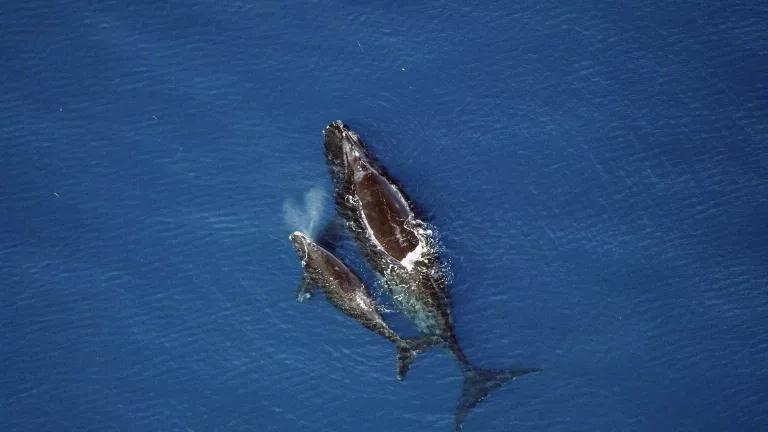Offshore Wind Done Right
We must advance offshore wind with the protections necessary to allow imperiled North Atlantic right whales to feed and migrate undisturbed.

© Florida Fish and Wildlife Conservation Commission, NOAA Research Permit # 594-1759.
Protecting the North Atlantic right whale during development
We need offshore wind, and we need to do it right. Offshore wind will help eliminate dangerous greenhouse gas emissions, promising healthier air as well as thousands of well-paying clean energy jobs. But as we fight climate change, we can and must avoid, minimize, and mitigate threats to ocean life.
Given the precarious status of the North Atlantic right whale, responsible offshore wind development means that we must advance this important new U.S. industry with the protections necessary to allow these whales to feed and migrate undisturbed. The Biden administration took a significant step forward this month to do just that.
The Bureau of Ocean Energy Management and the National Oceanic and Atmospheric Administration have announced an important multi-agency initiative to increase protections for the critically endangered North Atlantic right whale during offshore wind activities. With the agencies at the helm of offshore wind management and right whale conservation leading the effort, this broad initiative will collect information from all corners of government and work with scientists and right whale experts to set regional-scale right whale monitoring priorities. Of utmost importance, the agencies will develop a “management strategy to protect and promote the recovery of North Atlantic right whales while responsibly developing offshore wind energy.”
Action from the federal government cannot come soon enough. Mitigation requirements to further guard against vessel strikes and harmful noise levels must be part of the plan.
With fewer than 340 individuals remaining, the North Atlantic right whale is in dire straits. The species is rapidly declining due to vessel strikes and fishing gear entanglements and faces a multitude of additional threats, including underwater noise pollution and malnourishment, all while fighting to adapt to climate change. With the species simply unable to withstand further loss or disturbance, the right whale crisis is not a problem caused by the offshore wind industry, but it is one the industry must face.
Developing a strategy to protect the imperiled right whale population from day one of commercial-scale offshore wind development in U.S. waters showcases the Biden administration’s commitment to fight climate, and to stem biodiversity loss. Turbine construction for the nation’s first commercial-scale projects begins offshore New England in early 2023. This region represents a vitally important feeding area and migratory corridor for the species. We have a unique, but brief, period before steel goes in the water to layer in further necessary North Atlantic right whale protections for these projects and to shape future ones.
This strategy announcement is an excellent step. However, BOEM cannot wait. Mitigation plans for any offshore wind projects must:
- Keep vessel speeds for all boats on the water at 10 knots or less. Even a single vessel strike from any boat operating anywhere on the water has major ramifications on the ability of the North Atlantic right whale population to survive. Slower speeds will also benefit other endangered and threatened whales and sea turtles. Until there’s a real-time whale detection and response plan that’s been scientifically proven to meet or exceed the protections that could be provided by traveling at 10 knots, we must slow down to accommodate the species.
- Reduce noise generated by turbine installation (i.e., by using quiet foundations or technologies that significantly reduce pile driving noise) so that harmful noise levels are avoided at the outset. We need to increase visual and acoustic monitoring to make sure whales aren’t nearby before activities with potentially harmful noise levels start. We must also protect the species in the longer term, by advancing engineering solutions that reduce the noise levels generated by operating turbines.
NRDC is fighting to save the right whale from a host of threats – and to establish responsible offshore wind. We believe both these goals can be achieved and that for offshore wind to be successful in the long run, it must be paired with the necessary protections for ocean habitat and wildlife. The administration’s North Atlantic right whale strategy can help ensure that the needed mitigation and monitoring measures are in place to protect our valuable and vulnerable marine wildlife and habitat while expeditiously providing the critically needed clean energy to power our nation.
Fewer than 340 North Atlantic right whales remain on this planet.
Tell NOAA and BOEM to strengthen protections for this critically endangered species!




